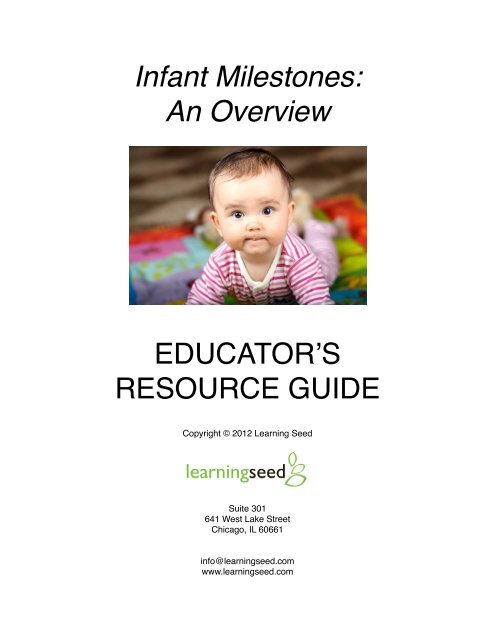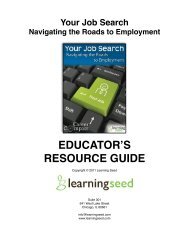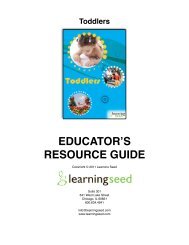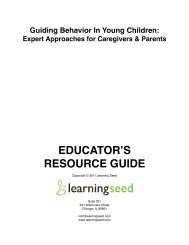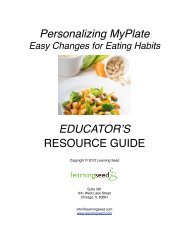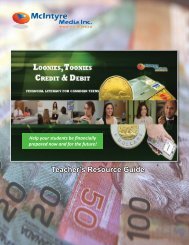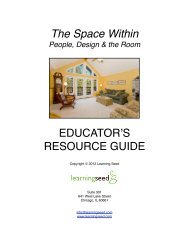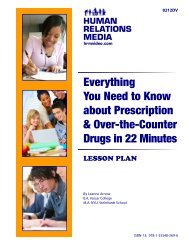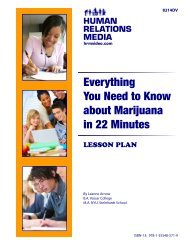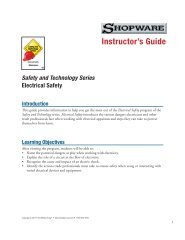Infant Milestones - Learning Seed
Infant Milestones - Learning Seed
Infant Milestones - Learning Seed
Create successful ePaper yourself
Turn your PDF publications into a flip-book with our unique Google optimized e-Paper software.
<strong>Infant</strong> <strong>Milestones</strong>:<br />
An Overview<br />
EDUCATOR’S<br />
RESOURCE GUIDE<br />
Copyright © 2012 <strong>Learning</strong> <strong>Seed</strong><br />
Suite 301<br />
641 West Lake Street<br />
Chicago, IL 60661<br />
info@learningseed.com<br />
www.learningseed.com
What’s in this Guide...and How to Use It!<br />
Program Overview • Video chapter titles and key concepts p. 3<br />
Before & After<br />
Viewing the Program<br />
• Prompts for writing or discussion<br />
Use prompts to initiate a:<br />
- class discussion<br />
- pair-share (partners discuss the prompt; each partner<br />
reports one of the other person’s ideas)<br />
- quick-write (unplanned, written response)<br />
• Suggested activities to extend learning<br />
Graphic Organizer • Tool for taking notes during the video pp. 5-7<br />
Check Your<br />
Understanding<br />
Assessment • Quiz - True or False?<br />
• Answer key<br />
• Short-answer questions. Can be used:<br />
- during the video to keep students on track<br />
- after the video for in-class review or assessment<br />
- after the video as homework<br />
p. 4<br />
pp. 8-9<br />
• Answer key pp. 10-11<br />
p. 12<br />
p. 13<br />
Glossary • Definitions of key words and phrases from the video p. 14<br />
Educator’s<br />
Resources<br />
• National Standards addressed in the video<br />
• Useful Internet resources<br />
p. 15<br />
Legal Niceties • What you can do, and what you shouldn’t p. 16<br />
Related <strong>Learning</strong> <strong>Seed</strong> Programs<br />
• Pregnancy in Progress: Beginnings of Life<br />
• <strong>Infant</strong>s: Physical Development<br />
• <strong>Infant</strong>s: Cognitive Development<br />
!<br />
! <strong>Infant</strong> <strong>Milestones</strong>: An Overview<br />
• <strong>Infant</strong>s: Social & Emotional Development<br />
Copyright 2012 <strong>Learning</strong> <strong>Seed</strong> ! 2
Program Overview<br />
Chapter 1 - Introduction<br />
• During their first year of life, infants grow and develop at a rapid pace. This program outlines infant’s<br />
physical, cognitive, and social and emotional development and suggests ways caregivers can<br />
promote their child’s development.<br />
Chapter 2 - Physical Development<br />
• <strong>Infant</strong>s grow quickly: they triple their weight and grow 10 - 12 inches in their first year.<br />
• At birth, a complex network of nerve connections begins developing in infants’ brains. These<br />
connections are stimulated by infants’ interactions with the world around them.<br />
• <strong>Infant</strong>s are born with unlearned behaviors called reflexes. These behaviors, such as sucking, are<br />
protective and help them thrive. Reflexes develop into gross and fine motor skills.<br />
• For healthy growth, infants need adequate nutrition (breast milk is considered best) and sleep.<br />
Chapter 3 - Cognitive Development<br />
• Babies are born ready to learn. Their ability to think, reason, and remember grows with every<br />
experience.<br />
• Psychologist Jean Piaget theorized that children’s thinking and reasoning abilities develop in stages.<br />
<strong>Infant</strong>s are in the “sensorimotor” stage, in which they move from simple reactions to the world to<br />
behaving in deliberate ways to achieve a desired effect.<br />
• Another theory, called information processing, explains how we mentally process information. It<br />
includes three steps: encoding, storage, and retrieval.<br />
• <strong>Infant</strong>s’ ability to express themselves grows from crying to babbling to speaking words.<br />
Chapter 4 - Social and Emotional Development<br />
• Psychologist Eric Erikson’s theory identified stages of emotional development. The “trust vs. mistrust”<br />
stage is key to the kinds of relationships the child will be able to form with others. The theory also<br />
states that while “personality” can be affected by caregivers, temperament is present at birth.<br />
• Secure infant-caregiver “attachment” relationships are essential to building trust. <strong>Infant</strong>s’ bonds with<br />
caregivers help them manage stranger and separation anxiety.<br />
• <strong>Infant</strong>s increasingly use “social referencing,” looking to others to see how they react, for help in<br />
understanding the meaning of and responding appropriately to different situations.<br />
Chapter 5 - Review<br />
!<br />
! <strong>Infant</strong> <strong>Milestones</strong>: An Overview<br />
Copyright 2012 <strong>Learning</strong> <strong>Seed</strong> ! 3
Before and After<br />
Prompts to generate interest, ideas, and inquiry<br />
Before viewing<br />
To spark interest, activate prior knowledge, and set a purpose for viewing<br />
• What do infants know at birth? How do they learn? Does the way the primary caregivers<br />
interact with a baby determine what the baby will be like as an adult?<br />
After viewing<br />
To promote critical thinking<br />
• Why is it important for parents to understand that babies’ brains begin developing neural<br />
connections at birth and that they’re born ready to learn?<br />
• At 9 months, babies can crawl, pull themselves up, and grasp objects. They also have the<br />
cognitive ability to achieve a desired goal. How might these simultaneous developments<br />
create challenges for parents, and what can caregivers do to nurture, rather than inhibit, a<br />
baby’s development at this time?<br />
• Reflect on the concept of temperament and “goodness-of-fit.” What temperament were you<br />
as a baby? How well do you think your temperament matched the environment you were<br />
raised in? Explain whether you think it’s important for a caregiver to be aware of an infant’s<br />
temperament, and why.<br />
After viewing<br />
To extend learning<br />
!<br />
! <strong>Infant</strong> <strong>Milestones</strong>: An Overview<br />
• Instruct students to create a booklet of sensory activities parents and caregivers can do<br />
with infants to help them learn about their world. Consider vision, hearing, taste, smell,<br />
and touch. For an additional challenge, students can include a “background” section in<br />
which they explain why sensory stimulation is so important to a baby’s development.<br />
• Direct students to use internet resources to research attachment. The Zero to Three<br />
organization (www.zerotothree.org) is a good resource. Then have students create a<br />
chart that shows the characteristics of caregivers that foster secure attachment (such as<br />
sensitivity and positive attitude) and specific examples of things parents can do to exhibit<br />
those characteristics.<br />
Copyright 2012 <strong>Learning</strong> <strong>Seed</strong> ! 4
Name<br />
Date<br />
_________________________________________________________________<br />
____________________________________ Class Period _______________<br />
While You Watch...use the graphic organizer to record key words and information.<br />
INFANT MILESTONES<br />
Domain Development When What<br />
Physical body<br />
brain<br />
!<br />
! <strong>Infant</strong> <strong>Milestones</strong>: An Overview<br />
reflexes<br />
gross motor<br />
fine motor<br />
Copyright 2012 <strong>Learning</strong> <strong>Seed</strong> ! 5
INFANT MILESTONES<br />
Domain Development When What<br />
Cognitive Piaget’s Theory:<br />
Social/<br />
Emotional<br />
Sensorimotor<br />
Stage<br />
Information<br />
Processing<br />
Theory<br />
!<br />
! <strong>Infant</strong> <strong>Milestones</strong>: An Overview<br />
Communication<br />
Expressing<br />
Emotions<br />
Stranger Anxiety<br />
Substages:<br />
1:<br />
2:<br />
3:<br />
4:<br />
12-24 mo. 5: Tertiary Circular Reactions<br />
6: Early Representational Thought<br />
Copyright 2012 <strong>Learning</strong> <strong>Seed</strong> ! 6
INFANT MILESTONES<br />
Domain Development When What<br />
Social/<br />
Emotional Separation<br />
Social/<br />
Emotional<br />
Anxiety<br />
Social<br />
Referencing<br />
Erikson’s<br />
Theory:<br />
!<br />
! <strong>Infant</strong> <strong>Milestones</strong>: An Overview<br />
Trust v.<br />
Mistrust Stage<br />
Personality &<br />
Temperament<br />
Attachment:<br />
Copyright 2012 <strong>Learning</strong> <strong>Seed</strong> ! 7
Name<br />
Date<br />
!<br />
! <strong>Infant</strong> <strong>Milestones</strong>: An Overview<br />
_________________________________________________________________<br />
____________________________________ Class Period _______________<br />
Check Your Understanding<br />
Write short answers for the following questions about the <strong>Infant</strong> <strong>Milestones</strong> video:<br />
1. How do babies learn about their world?<br />
2. How do experiences affect the nerve cells, or neurons, in an infant’s brain?<br />
3. What is a reflex? Give 2 examples.<br />
4. What is the difference between gross motor skills and fine motor skills?<br />
5. According to experts, how long should infants be breast-fed?<br />
Copyright 2012 <strong>Learning</strong> <strong>Seed</strong> ! 8
!<br />
! <strong>Infant</strong> <strong>Milestones</strong>: An Overview<br />
Check Your Understanding (continued)<br />
6. Name a psychologist who developed an important theory about child development.<br />
7. What do children do in the ”secondary circular reactions” substage of Piaget’s sensorimotor<br />
stage?<br />
8. What are two ways infants express emotions before they can speak?<br />
9. How do infants learn who they are?<br />
10. What are the two components of attachment?<br />
Copyright 2012 <strong>Learning</strong> <strong>Seed</strong> ! 9
Check Your Understanding Answer Key<br />
Write short answers for the following questions about the <strong>Infant</strong> <strong>Milestones</strong> video:<br />
1. How do babies learn about their world?<br />
Through their senses.<br />
2. How do experiences affect the nerve cells, or neurons, in an infant’s brain?<br />
More synapses, or connections, are created.<br />
3. What is a reflex? Give 2 examples.<br />
Reflexes are unlearned, involuntary responses to stimuli.<br />
Possible examples:<br />
rooting, sucking, gag, swimming, eye-blink, startle, Moro, stepping<br />
4. What is the difference between gross motor skills and fine motor skills?<br />
Gross motor skills involve the large muscles of the arms, legs, and abdomen.<br />
Fine motor skills involve the small muscles of the hands and wrists.<br />
5. According to experts, how long should infants be breast-fed?<br />
12 months.<br />
!<br />
! <strong>Infant</strong> <strong>Milestones</strong>: An Overview<br />
Copyright 2012 <strong>Learning</strong> <strong>Seed</strong> ! 10
Check Your Understanding Answer Key (continued)<br />
6. Name a psychologist who developed an important theory about child development.<br />
Jean Piaget, OR Eric Erikson<br />
!<br />
! <strong>Infant</strong> <strong>Milestones</strong>: An Overview<br />
7. What do children do in the”secondary circular reactions” substage of Piaget’s sensorimotor<br />
stage?<br />
They interact with objects around them, and they repeat pleasing actions.<br />
8. What are two ways infants express emotions before they can speak?<br />
Possible answers:<br />
Crying, facial expressions, pointing, gesturing.<br />
9. How do infants learn who they are?<br />
Through interactions with caregivers.<br />
10. What are the two components of attachment?<br />
! The infant’s need for protection and comfort, and the parents’ giving of care in response<br />
! to these needs.<br />
Copyright 2012 <strong>Learning</strong> <strong>Seed</strong> ! 11
Name<br />
Date<br />
!<br />
! <strong>Infant</strong> <strong>Milestones</strong>: An Overview<br />
_________________________________________________________________<br />
____________________________________ Class Period _______________<br />
! !<br />
Quiz - True or False?<br />
Write T or F in the blank to tell whether the statement is True or False.<br />
___ 1. Most of an infant’s time is spent eating or sleeping.<br />
___ 2. At birth, infants must be taught all of their behaviors.<br />
___ 3. All infants develop at the same rate.<br />
___ 4. <strong>Infant</strong>s develop gross motor and fine motor skills simultaneously.<br />
___ 5. Memories are created in infants’ brains through repetition of experiences.<br />
___ 6. Until they can babble words, infants are not able to communicate.<br />
___ 7. <strong>Infant</strong>s can understand full sentences by age 1.<br />
___ 8. Being around unfamiliar people contributes to stranger anxiety in infants.<br />
___ 9. <strong>Infant</strong>s’ emotional bonds with their primary caregivers have very little effect on<br />
their future relationships.<br />
___ 10. Consistency and routines help babies develop a sense of trust.<br />
Copyright 2012 <strong>Learning</strong> <strong>Seed</strong> ! 12
!<br />
! <strong>Infant</strong> <strong>Milestones</strong>: An Overview<br />
Quiz - True or False? Answer Key<br />
T 1. Most of an infant’s time is spent eating or sleeping.<br />
F 2. At birth, infants must be taught all of their behaviors.<br />
<strong>Infant</strong>s have reflexes such as rooting and sucking, to get food; and gagging<br />
and blinking, to keep them safe.<br />
F 3. All infants develop at the same rate.<br />
<strong>Infant</strong>s experience the same stages of development, but may go through<br />
them at different rates.<br />
T 4. <strong>Infant</strong>s develop gross motor and fine motor skills simultaneously.<br />
T 5. Memories are created in infants’ brains through repetition of experiences.<br />
F 6. Until they can babble words, infants are not able to communicate.<br />
<strong>Infant</strong>s cry and use facial expressions, such as a smile, to get responses from<br />
caregivers; pointing and gesturing are also forms of communication.<br />
T 7. <strong>Infant</strong>s can understand full sentences by age 1.<br />
F 8. Being around unfamiliar people contributes to stranger anxiety in infants.<br />
The more experience infants have around unfamiliar people, the less<br />
stranger anxiety they tend to show.<br />
F 9. <strong>Infant</strong>s’ emotional bonds with their primary caregivers have very little effect on<br />
their future relationships.<br />
If infants have a sense of trust, they will feel hopeful and secure that their<br />
future needs will be met.<br />
If infants feel mistrustful, they may view the world as unfriendly and have<br />
difficulty forming bonds with others.<br />
T 10. Consistency and routines help babies develop a sense of trust.<br />
Copyright 2012 <strong>Learning</strong> <strong>Seed</strong> ! 13
Glossary<br />
attachment The two-way process through which infants form emotional bonds with<br />
another person—particularly a parent.<br />
cognitive Ability to think, reason, and remember.<br />
fine motor skills Movements using the small muscles of the hands and wrists.<br />
goodness-of-fit Development as affected by the match between infants’ temperaments and<br />
the demands of the environment they are being raised in.<br />
gross motor skills Movements using the large muscles of the arms, legs, and abdomen.<br />
information<br />
processing theory<br />
A description of mental processes that includes encoding (storing<br />
information in a usable form); storage (placement of information into<br />
memory); and retrieval (locating and using information in memory).<br />
object permanence Understanding that objects and people exist even when they cannot be<br />
seen.<br />
personality Total of the characteristics that differentiate one person from another; may<br />
be influenced by environmental factors.<br />
pincer grasp Holding on to objects with the thumb and forefinger.<br />
primary and<br />
secondary circular<br />
reactions<br />
!<br />
! <strong>Infant</strong> <strong>Milestones</strong>: An Overview<br />
<strong>Infant</strong>s’ repetitive, pleasurable activity focused first on themselves (1-4<br />
months), then on interaction with the world outside of their own bodies (4-8<br />
months).<br />
productive speech Vocalization of sounds to express oneself.<br />
receptive language Ability to understand what others are saying and respond accordingly.<br />
reflex Unlearned, involuntary response to a stimulus, such as sucking or gagging.<br />
social referencing Looking to others to see how they react, for help in understanding the<br />
meaning of different situations.<br />
separation anxiety Distress shown by infants when their usual caregiver leaves.<br />
stranger anxiety <strong>Infant</strong>s’ wariness when they encounter an unfamiliar person.<br />
synapses Complex network of neuron connections that lay the foundation for<br />
intelligence and emotional health.<br />
temperament Consistent, enduring patterns of emotion that are present at birth.<br />
Copyright 2012 <strong>Learning</strong> <strong>Seed</strong> ! 14
Resources for Educators<br />
Educational Standards<br />
National Standards for Family and Consumer Sciences<br />
4 Education and Early Childhood<br />
4.2.1 Analyze child development theories and their implications for educational and<br />
childcare practices.<br />
4.2.4 Analyze abilities and needs of children and their effects on children's growth and<br />
development.<br />
4.2.5 Analyze strategies that promote children's growth and development.<br />
NAEYC - Standards for Early Childhood Professional Preparation Programs<br />
1 Promoting Child Development and <strong>Learning</strong><br />
1a Knowing and understanding young children’s characteristics and needs, from birth<br />
through age 8.<br />
1b Knowing and understanding the multiple influences on early development and<br />
learning.<br />
1c Using developmental knowledge to create healthy, respectful, supportive, and<br />
challenging learning environments for young children.<br />
Useful Internet Resources<br />
!<br />
! <strong>Infant</strong> <strong>Milestones</strong>: An Overview<br />
• Child Development Institute/Parenting<br />
childdevelopmentinfo.com<br />
The site includes detailed descriptions and easy-to-read charts of the stages of child development<br />
according to both Piaget’s and Erikson’s theories. There is also a parent directory with professional,<br />
research, and educational resources.<br />
• March of Dimes<br />
marchofdimes.com<br />
The March of Dimes provides resources on infant health for parents and professionals. Select “Baby”<br />
in the Categories menu to find informative videos and Q&A sections related to “Preparing for Your<br />
Baby,” “Caring for Your Baby,” and “Your <strong>Infant</strong>s Health.”<br />
• Bright Futures for Famlies (American Academy of Pediatrics)<br />
brightfuturesforfamilies.org<br />
Download one or more chapters of this organization’s illustrated “Family Pocket Guide,” which<br />
consists of user-friendly information on topics such as “Before the Baby is Born” and “Thinking about<br />
Infancy.” The appendices include recommendations for immunizations and a child care checklist.<br />
Copyright 2012 <strong>Learning</strong> <strong>Seed</strong> ! 15
Legal Niceties<br />
WHAT CAN I DO WITH THIS RESOURCE GUIDE?<br />
Copyright © 2012 <strong>Learning</strong> <strong>Seed</strong><br />
This resource guide is copyrighted according to the terms of the Creative Commons non-commercial<br />
license (http://creativecommons.org/licenses/by-nc/2.5/). It may be reproduced, in its part or its entirety,<br />
for classroom use. No part of this guide may be reproduced for sale by any party.<br />
You are free:<br />
• to copy, distribute, display, and perform this work.<br />
• to make derivative works.<br />
Under the following conditions:<br />
• Attribution. You must attribute the work to <strong>Learning</strong> <strong>Seed</strong>.<br />
• Noncommercial. You may not use this work for commercial purposes.<br />
• For any reuse or distribution, you must make clear to others the license terms of this work.<br />
Any of these conditions can be waived if you get permission from the copyright holder.<br />
Resource Guide Credits<br />
Writer: Esther Mozak<br />
Editor: Jodi Libretti<br />
Copy Editor(s): Jennifer Smith<br />
WHAT CAN I DO WITH THE VIDEO?<br />
Copyright © 2012 <strong>Learning</strong> <strong>Seed</strong><br />
This video is protected under U.S. copyright law. No part of this video may be reproduced or transmitted<br />
by any means, electronic or mechanical, without the written permission of the Publisher, except where<br />
permitted by law.<br />
DVD LS-1365-12-DVD ISBN 978-1-55740-621-7<br />
Closed Captioning<br />
This program is closed captioned.<br />
!<br />
! <strong>Infant</strong> <strong>Milestones</strong>: An Overview<br />
Questions, suggestions, or comments?<br />
E-mail us at info@learningseed.com or call 800.634.4941<br />
Copyright 2012 <strong>Learning</strong> <strong>Seed</strong> ! 16


